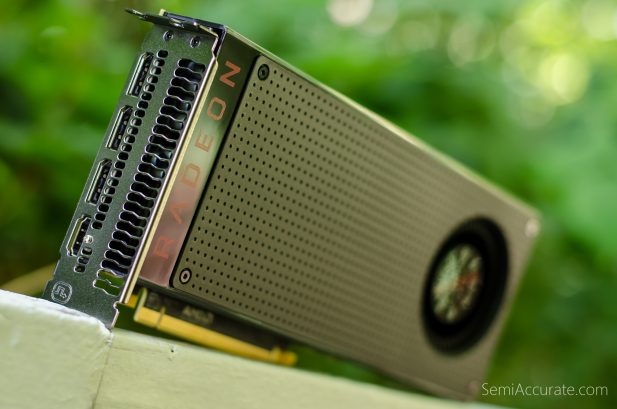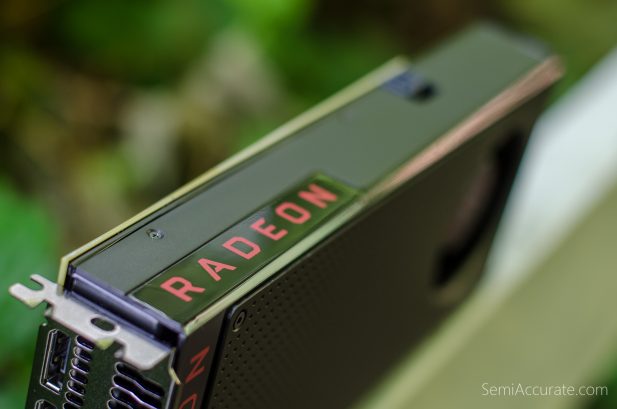In this article we’ll be addressing concerns that the RX 480 is throttling in games due to the limitations of its reference cooling solution. Additionally we’ll explore the impact on performance and power consumption that occurs when we use Radeon WattMan’s Power Limit slider to undervolt/underclock the RX 480.
Testing for Thermal Throttling
To isolate the effect of the RX 480 cooler we did two runs in our Battlefield 4 benchmark. The first run was with the RX 480’s stock settings and the second run was with the RX 480’s fan maxed out at a constant 100%. Looking at the data record by Radeon WattMan in the image above you can see that clocks didn’t vary far from the RX 480’s 1266Mhz boost clock speed in either scenario.
There is a marked difference in the temperature curve though as the stock profile slowly ramps the temps up to ~80 degree Celsius and then ramps the fan to keep temperatures pinned at about that level. With the RX 480’s fan maxed out load temperatures are lower by 5 to 10 degrees.
Looking at our power consumption charts we can see very similar profiles between the stock and full fan Battlefield 4 benchmarks. There is a slight difference where the RX 480 drew 5 to 10 more Watts of power with its fan maxed out than it did at stock. The similarity of these power consumption numbers and the lack of clock throttling indicate that the RX 480’s performance is more limited by its power consumption than by its cooling solution.
Finally we have the performance numbers where the stock fan profile and the maxed out fan perform basically the same in Battlefield 4. The RX 480 is not the R9 290X. If you’ll recall that graphics card showed significantly better performance after an adjustment to its fan curve to reduce thermal throttling. But that’s not the case here. Where the reference cooling solution become the limiting factor is when overclocking is involved. Our testing indicates that at stock clocks it’s not the primary factor limiting the RX 480’s performance in a mainstream gaming workload like Battlefield 4.
To add more credence to the ‘RX 480 is not thermal throttling at stock’ theory I set Battlefield 4 to run for about half an hour. Profiling the card with WattMan showed no significant clock speed throttling although it did show that fan speed continued to ramp up over time and temperatures sitting at around 84 degrees Celsius.
Playing with PowerTune
With that in mind let’s see what happens when we raise and lower the RX 480’s PowerTune limit in 10 percent increments.
In the image above the first load period is with the RX 480’s PowerTune setting at +10%. As the log here demonstrates the RX 480’s clockspeed, thermal, and fan performance was impacted to only a small degree by increases in its PowerTune limit.
In this image the first load period is the RX 480’s stock clocks and the second load period is a -10% PowerTune setting. Negative PowerTune settings have a very clear impact on the sustained clockspeeds that the RX 480 is able to achieve. The thermal situation stays about the same but fan speeds decline. At the -50% setting clock speeds plummet to a mere 503 Mhz.
Looking at our power consumption graphs it appears that the RX 480’s stock setting are relatively well aligned to its absolute need for power. By bumping the PowerTune limit to +10% power consumption rises from an average of about 355 Watts up to 365 Watts. At +20 and +30% we see about 360 Watts and at +40 and +50 it drops to 355 Watts. It appears that the RX 480 is not significantly power consumption limited in its stock form. But as we touched on in our original review that’s not necessarily true in overclocked scenarios.
This graph starts with load power consumption at the RX 480’s stock settings. Then we started reducing the PowerTune limit in increments of 10%. The power consumption of our RX 480 wasn’t significantly affected until we set our PowerTune limit to at least 20% at which point it the total system power draw is reduced by 30 Watts. If we cross-reference this with our WattMan clockspeed profiling we can see that this reduction in power consumption happens in concert with the RX 480 throttling itself to around its 1120Mhz base clock speed. This pattern of aggressive clock speed throttling continued as we decreased the PowerTune limit until we maxed it out.
With a -50 PowerTune limit our system drew only 255 Watts under load which is ~100 Watts less than what our system drew at the RX 480’s stock settings.
Finally we can look at the performance impact of changing the RX 480’s PowerTune setting. There are a few points worth discussing here; first off there’s little to gain from increasing the RX 480’s PowerTune limit if you are running the card with its stock clocks. There’s still a performance gain to be had from bumping it up to +10% but it’s rather small. The -10% and -20% settings also have a very limited impact on the performance of the RX 480. At -30% performance starts to fall off of a cliff and that trend continues as we look at the -40 and -50% settings.
Thanks to the table above we can bring average system power consumption into our discussion of performance and PowerTune settings. We can see that the RX 480 reaches its peak efficiency around the -20% PowerTune setting. Recalling our clock speed profiling from earlier at this setting the RX 480 was throttling down to around its 1120 Mhz base clock. Below this point of maximum efficiency the RX 480 gets progressively worse performance per watt as we continue to constrain its power consumption.
There has been suggestions that the RX 480’s clock speeds were pushed up significantly at the last minute which resulted in disproportionately worse efficiency than AMD had originally intended. Our result show that this is not the case. In fact the RX 480’s stock clocks are very close to its highest point of efficiency.
Conclusion
Leave the RX 480’s fan profile alone. It works fine for the card at stock clocks in gaming workloads. If you overclock or run power viruses like Furmark your mileage may vary.
If you want the best performance the RX 480 can offer without overclocking, bump the PowerTune limit to +10%. If efficiency is your goal consider setting your PowerTune limit to -20%. You’ll lose about 5% in terms of raw performance, but the decrease in power consumption is greater proportionally than the performance hit.S|A
Thomas Ryan
Latest posts by Thomas Ryan (see all)
- Intel’s Core i7-8700K: A Review - Oct 5, 2017
- Raijintek’s Thetis Window: A Case Review - Sep 28, 2017
- Intel’s Core i9-7980XE: A Review - Sep 25, 2017
- AMD’s Ryzen Pro and Ryzen Threadripper 1900X Come to Market - Aug 31, 2017
- Intel’s Core i9-7900X: A Review - Aug 24, 2017












